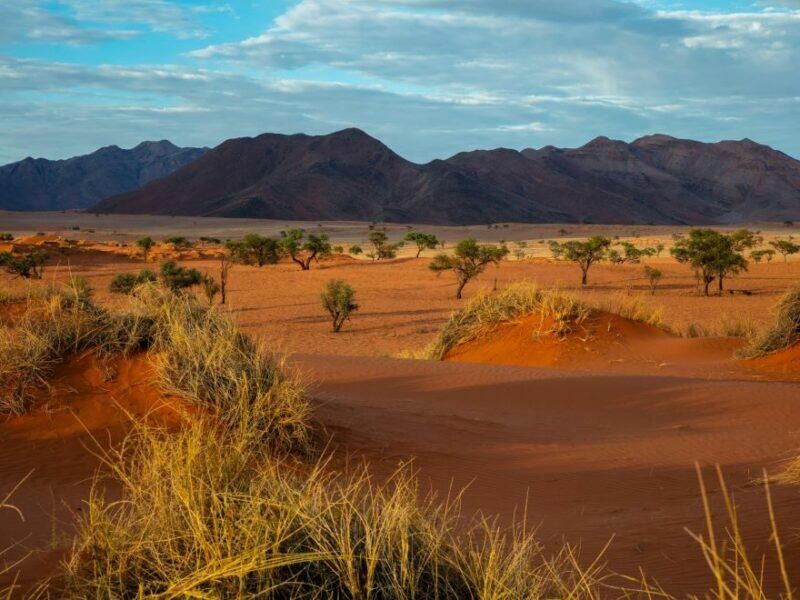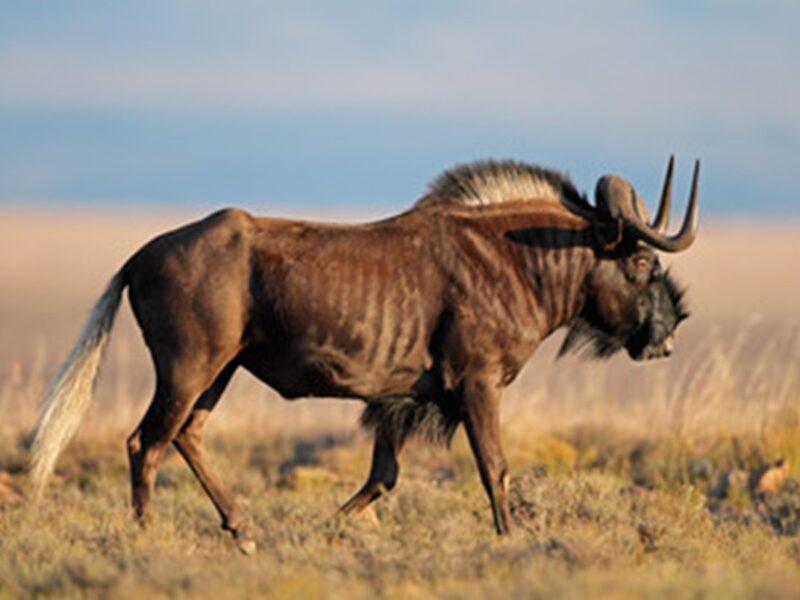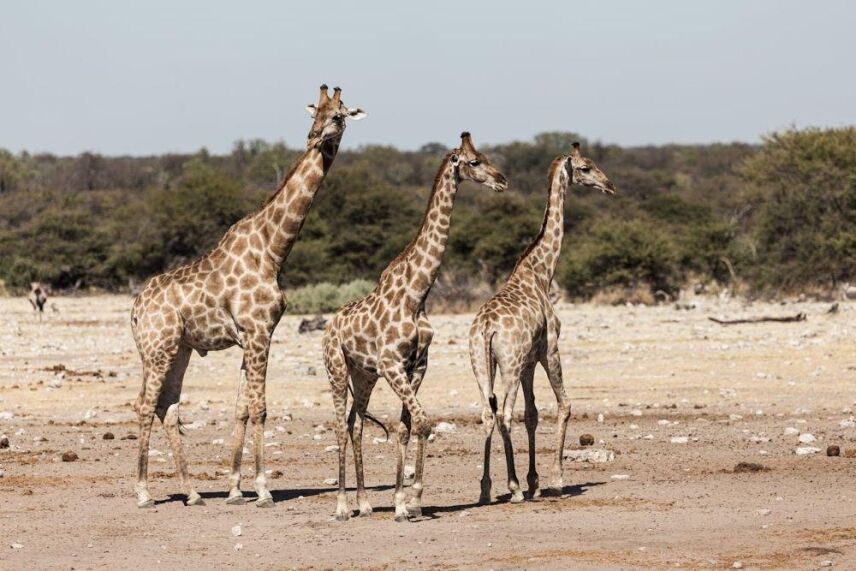A hunting safari in Namibia is both challenging and rewarding. With the lowest rainfall in sub–Saharan Africa, you’d not think that this land can support the sheer abundance of wildlife that calls this desert country home! Namibia has long been a top game hunting destination thanks to this varied collection of big game and plains game alike, adding to this is the option of returning to the roots of hunting, with Namibia bow hunting safaris.
Bow hunting has been legal in Namibia since 1997, and thanks to Namibia having some of the most sustainable hunting safari practices, there’s more than enough game to go around.
[DYNAMIC-BLOGTABLEOFCONTENT]
Bow Hunting Safaris in Namibia
Bow hunting traces back to the days of early man and our hunter-gatherer forefathers. Put simply, it can be described as the practice of hunting animals through the use of archery equipment. Game hunting with this method has become increasingly popular over the years and is sometimes seen as a more “niche” class of hunting as many hunts available online cater to those using rifles or other firepower.
Bow hunting requires a carefully honed set of skills that come with time (as well as trial and error) and a hunting safari in Namibia is a sure way to get in some wonderful practice.
The appeal of Namibia hunting Trips: A Game Hunting Playground
Hunting in Namibia runs from February to November and most days will see sunshine and clear skies. The start of season begins in Namibia’s summer peak where desert areas can reach over 100ºF, humidity can run high, and occasional afternoon showers are known to come around. As summer continues, both humidity and heat peter out with an average daytime high between 75º and 85º Fahrenheit. The winter months can bring nighttime temperatures below 0º F and daytime averages of around 50º F.
These seasons drive animals across the desert plains in search of commodities like food, water, and shade. This keeps life moving around the dunes and ensures a fresh regeneration of the heard who call Namibia home. Namibia’s wildlife is well-adapted to this environment and hunters can be assured of decent trophy options and well-managed quotas keeping the industry going.

A Bow Hunting Safari in Namibia: Targets and Methods
When it comes to bow hunting in Namibia, dangerous game like the Big Five are unfortunately off the cards as Namibia prohibits big game hunting using a bow. However, Namibia still has a host of African plains game on offer to pique any hunter’s interest.
A variety of game ranging from antelope and other plains species as well as small predators is available when on a bow hunting safari in Namibia and these can still deliver an enjoyable and memorable game hunting experience.
Antelope of the dunes
· Wildebeest
Nicknamed the “poor man’s buffalo,” both species of Wildebeest can be hunted in regions across Namibia hunting grounds, from the free desert to private game farms. Neither species requires a special permit and in terms of bow hunting, is considered to be large game.
The blue wildebeest (Connochaetes taurinus) is a tough animal to bring down and is commonly found spread from the southeast semi-arid area right up to the Caprivi, where conditions can be more tropical. Black wildebeest (Connochaetes gnou) were brought to Namibia (among other countries) from their native homeland of South Africa. Numbers of this wildebeest are lower than those of the blue but aren’t cause for alarm. Black wildebeest are a bit smaller than their counterparts and are usually found in set populations across Namibia’s grassland.

· Eland
The common eland (Taurotragus oryx) is a trophy specimen to behold, as the second largest antelope worldwide and boasting impressive horns to boot, this antelope can be found across Namibia’s hunting safari grounds from the north to the east and south. A less common eland found only in the north or Caprivi region is the Livingstone eland (Taurotragus oryx livingstonii), a “rarer” species of eland in this part of Africa.
· Red Hartebeest
“Why the long face” is a phrase that can easily describe the only hartebeest species of Namibia. With an unusually shaped facial structure and recognizable markings, the Red or Cape hartebeest makes a distinct trophy. Living in small herds well-adapted to the blazing Namibian desert, red hartebeest calls the arid Kalahari Desert region home.
· Oryx
The gemsbok (Oryx gazella) is a variant of Oryx almost synonymous with its endemic Namibia. Known for its characteristic light-colored coat of hair marked by dark patches along the side of the belly and hind legs, as well as dark face markings and white socks, the gemsbok makes for a beautiful trophy whether for the skin or horns. This Namibian Oryx utilizes its brilliant eyesight to scan the expanse of the Kalahari Desert region it calls home, worth noting to stay out of sight (and avoid casting shadows).
· Burchell’s zebra
One cannot think of Africa and not picture herds of zebra galloping across the savanna. The most common of the plains zebra species, Burchell’s zebra (Equus quagga burchellii) are distinguished through their light brownish–colored shadow stripe between the signature black and white as well as the fact that their stripes meet under the belly. The Burchells can be found in Namibia’s less arid central areas due to their need for water, however, they can handle lower-quality grazing fare by munching through long grasses.
· Common waterbuck
The common waterbuck (Kobus ellipsiprymnus) is the most commonly found waterbuck subspecies when it comes to game hunting across Africa. A large antelope known for their darker colored shaggy haired coats and horns of up to 39 inches (only the males). Waterbuck are sedentary and can never be too far away from a source of water, meaning waterbuck hunting safari in Namibia tend to take place on private ranches in Namibia’s central areas.
· Impala
Another water-dependent species that has managed to adapt and survive in the sands of Namibia is the impala. There are two subspecies of this medium-sized antelope found in the country; namely the common impala (Aepyceros melampus) in the eastern regions, and the black-faced impala (Aepyceros melampus petersi) in the north.
· Kalahari springbok
If ever there was a species of animal made to survive the harsh African landscape, it’s the Springbok. Notably, the Kalahari subspecies known for their thicker horns and slightly larger build can be found across Namibia’s Kalahari region in large free-ranging herds.
· Greater kudu
Known as the “gray ghost,” the greater kudu (Tragelaphus strepsiceros) is a large antelope famous for its impressive jumping abilities that ensure hardly a fence gets in their way. Males of the species can measure around 5 feet at the shoulder and grow impressive spiral-shaped horns. This majestic antelope can be found nationwide with Namibia hunting opportunities concentrated around the central region near Windhoek.
· Blesbok
Originally a native antelope to neighboring South Africa, the Blesbok (Damaliscus pygargus phillipsi) is a subspecies of Bontebok and is famous for the white patch that runs across their muzzle and forehead. This patch is how the Blesbok got its name; the word “bles” in Afrikaans means “bald” and this patch gives the antelope a look as though their copper-toned coat doesn’t quite cover their face. Blesbok are water dependent and their hunting safari in Namibia can be planned not far from water sources.
Alternative plains species
· Giraffe
A species needing no introduction, the giraffe is an icon of the African savannahs. Most commonly found in Namibia is the Angolan or Namibian giraffe (G. c. angolensis) which are distinguished by their lighter base color and lack of markings on the central and upper face, as well as white ear tips.
· Chacma baboon
One of the largest members of the monkey family, the Chacma baboon (Papio ursinus) is commonly hunted for being a “problem species.” These primates can be challenging hunts due to their intelligence and incredible eyesight, both strengths employed by the “sentries” of the troupe to keep an eye out for danger. Chacma can be found across Namibia from the grassy plains to the savannah, and even the hills; but be warned, an injured baboon can be a danger thanks to their large canine teeth.
· Damara dik-dik
A card-carrying member of the Tiny Ten club, the Damara (Madoqua kirkii) is well and truly an alternative to big game hunting in Namibia. Endemic to the country, they can be found in the home territory of the rocky hills south of Etosha. These small antelope require patience to hunt but don’t be fooled by their size, Damara dik-dik are highly territorial as well as nocturnal in behavior.
Small Desert Predators
· Caracal
A medium-sized wildcat native to Africa (among other countries), the caracal (Caracal caracal) has a striking appearance thanks to their slender yet powerful build and unusual markings around the face and ears. Caracal are both nocturnal and secretive in nature meaning they require a bit of effort and patience when a part of your hunting safari. These desert felines are spread across Namibia and are known as keen hunters themselves, sometimes taking down fully grown springbok.
· African wildcat
Calling the savannah areas of Namibia home, the African wildcat (Felis lybica) is known for its strong resemblance to typical domestic cats. With short grey to sandy – grey color fur and ear tufts similar to the caracal, these nocturnal felines are known for strong climbing abilities and their solitary nature.
· Jackal
Namibia is home to two variants of jackal depending on where your game hunting is planned. The famed Caprivi region is home to the Side Striped jackal (Lupulella adusta), while the common Black – Backed jackal thrives in an area stretching from the inland Namibian Desert right across to the Skeleton Coast. Both species can be hunted at night with the use of a spotlight (with special permission), taking advantage of their nocturnal wanderings.
Wing shooting
A burgeoning and well–known Namibia hunting industry, is wing shooting. With growing popularity in recent years, taking on the avian varieties on offer is a great way to add something a little more different to the hunting safari selection. Some species can be found across the country, while others are tied to particular regions; wing shooting availability is also slightly more controlled due to specified breeding seasons of the birds in question. Some examples of bird species available for hunting include:
- Sandgrouse
- Francolin
- Quail
- Dove
- Guinea fowl
Bow Hunting Safari Guidelines
Just like with rifles and the relative ammunition, bow hunting in Namibia is regulated according to a set of guidelines that stipulates the minimum requirements needed to ensure a hunt that is as ethical and humane as possible.
Small game
This category of the game includes species like Springbok, Dik–Dik, Duiker, and small predators as well as the wing shooting targets are considered small game and can be hunted as below:
25ft per pound draw mass and 350-grain arrow
Medium game
Species such as baboon, Impala, Blesbok, and Warthog are grouped under the medium game category and require the following:
40ft per pound draw mass and 400-grain arrow
Large game
Almost all of the plains game on offer on Namibia hunting packages are grouped under the large game banner. These include giraffe, Oryx, eland, zebra, Impala, wildebeest, Kudu, Blesbok, etc.
65ft per pound draw mass and 450-grain arrow
Some Namibia hunting laws and regulations on bow hunting
- As mentioned above, the use of a bow when on big game hunting safari in Namibia is prohibited. While other countries like South Africa do allow big game hunting with the use of a bow, Namibia does not.
- Arrows made from wood, carbon and carbon compounds, aluminum, and fiberglass are allowed.
- Broadhead arrows are accepted provided they have two fixed cutting blades and a minimum width and length of one inch.
- Broadheads may not be serrated or poison-tipped.
- When wing shooting, judo point, blunt point, and bird point broadheads may be used.
- Any bow hunting in Namibia requires the presence of a PH or Master Hunting Guide who has the additional bow hunting qualifications necessary, they must also be registered as a bow hunting guide. Bow hunting may only take place on private game farms where permission for bow hunting has been granted.
- Hunting safari licenses need to specify “bow hunting” as the method before being submitted to the Namibian Ministry of Environment and Tourism (MET).
- Trophies submitted for inclusion in record lists can be disqualified if the incorrect permit was issued.
- Shooting from a vehicle is against the law.
- Bow hunting, like regular hunting practices, needs to adhere to Namibia’s fair – chase guidelines.
- Fair chase is described as the pursuit of an animal in a free or enclosed roaming area where the possibility of escape or evasion is evident and available.
- No hunting is allowed from 30 minutes after sunset until 30 minutes before sunrise; unless the hunter has been granted special permission from the MET.
- A hunter may only hunt 2 trophies of a given species in a one-year period.
- Bow hunting is only allowed for the activity of trophy hunting.
Applications for A Bow Hunting Safari in Namibia
Just like with rifle hunting, bow hunting can be employed under different methods and conditions that can be tweaked or adjusted to accommodate the elements, species targeted, and the hunter’s abilities.
Spot and stalk
These hunts typically involve using a vehicle to reach a hunting destination, upon arrival, the hunting party proceeds on foot to the desired area tracking the animal or herd through their tracks, gathering information, knowing areas to inhabit, etc. Spot and stalk are typically chosen when the hunter is targeting an animal not known for frequenting the salt licks or watering holes.
This method is often used during the “greener” months as they are known, from February until the beginning of June. At this time the ground is softer, minimizing the sound carry of footsteps, and with bush can provide sufficient cover when stalking the target.
Blind
Many bow hunting areas have permanent or semi-permanent blind structures erected such as ground or tree blinds, or movable “pop–up” blinds that can be transported to different locations. A blind requires the hunter to be within 60 – 100 feet of the target while being as still and silent as possible.
In Namibia, blinds are traditionally used when on hunting safari in the dry winter time months of June to November as they can give a measure of protection against the elements when spending hours in the desert winter. Hunting from a blind can allow for a better shot success as the hunter can properly scout the animal and take a broadside shot, as headshots aren’t a popular suggestion in a blind hunting situation.
Things to keep in mind when bow hunting in Namibia
Bow hunting in Namibia, and anywhere else for that matter, calls for a somewhat different approach. This method of game hunting can be described as a more intimate method requiring more patience and an almost slowed-down approach. Bow hunting involved the hunter needing to be in a much shorter or closer “firing range” when compared to rifle hunting, meaning hunters need to exercise even more caution and consideration when approaching the target animal or group. Shot placement in even the most perfect setup can be challenging, and bow hunting requires almost precision–like aim. There is no room for error and ensuring correct and accurate shot placement keeps the bow hunting as humane as possible.
Bow hunting also requires its special tools and “spares” that need to be packed in should the hunter need to use extras or make repairs on the go; and while most hunting safari outfitters can provide visitors with rifles, bows aren’t so freely available. Methodically listing the required equipment can go a long way to ensuring you are as prepared as possible, include items like:
- Extra strings
- Harnesses
- Sights and peeps
- Arrow bonnets
- Your carrier or bow sling
- Armguards, gloves, or face protection if used
- Sharpening tools
- Glue
- Weight tubes
- Targets
Bow hunting in Namibia is an exciting, thrilling, and challenging hunting safari never to be missed! If you enjoyed this article about Namibia, learn more about this fascinating destination.
Alternatively, see which Namibian hunts are available.
Author: A. Baker
